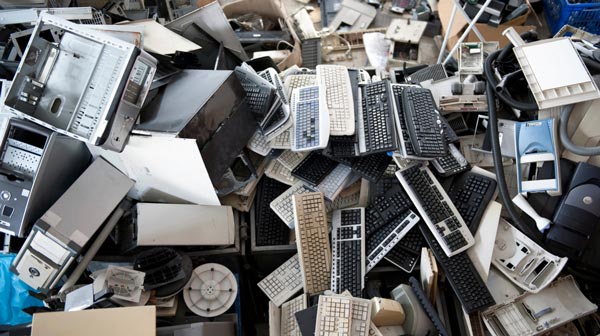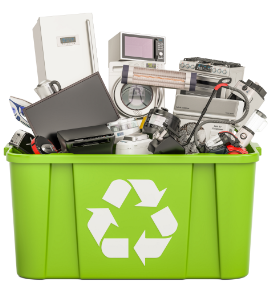Eco-Friendly Electronics Recycling Solutions: Depend On the R2 Certification Criterion
Wiki Article
Elevate Your E-Waste Administration With R2 Certification: a Comprehensive Review
One secret approach to elevate e-waste administration techniques is by attaining R2 accreditation. By discovering the benefits and processes associated with R2 accreditation, a much deeper understanding of how it can transform e-waste monitoring approaches emerges, dropping light on a course in the direction of sustainability and moral disposal practices.Significance of E-Waste Monitoring

When e-waste is not handled appropriately, these harmful materials can seep right into the ecosystem, creating harm to wild animals and potentially going into the food web, positioning threats to human health. The inappropriate disposal of e-waste contributes to pollution and greenhouse gas emissions, worsening environment change and environmental deterioration.

Benefits of R2 Certification

First of all, R2 qualification enhances reputation by showcasing an organization's devotion to sustainable methods. It assures consumers, partners, and stakeholders that the business sticks to stringent requirements for e-waste monitoring - r2 certification. This trustworthiness can bring about enhanced trust fund and improved connections with customers who prioritize ecological duty
Secondly, R2 accreditation assists minimize dangers connected with inappropriate e-waste disposal. By following the stringent standards stated by the qualification, organizations can reduce the probability of data violations, environmental contamination, and legal consequences. This aggressive approach safeguards the company's credibility and minimizes prospective obligations.
Finally, R2 qualification shows a dedication to ecological stewardship - r2 certification. By sensibly taking care of digital waste through accredited processes, organizations add to the conservation of resources, reduction of pollution, and promotion of a circular economy. This dedication not just profits the atmosphere yet additionally straightens with progressing customer assumptions for sustainable organization techniques
R2 Qualification Refine Introduction
Having actually established the benefits of R2 certification in advertising credibility, risk mitigation, and ecological stewardship, it is vital to currently lay out the in-depth process associated with obtaining this qualification. The R2 qualification process begins with a comprehensive review of the company's functional policies and treatments to make sure compliance with the R2 standard. This first analysis is vital in determining any voids that need to be addressed prior to proceeding further.As soon as the organization's practices line up with the R2 common needs, an independent third-party auditor carries out an on-site audit to evaluate the execution and effectiveness of these techniques. This audit includes a comprehensive review of paperwork, meetings with personnel, and physical inspections of centers to confirm compliance.
Complying with an effective audit, the organization obtains an accreditation choice based on the auditor's searchings for. If approved, the company is granted R2 accreditation, showing its commitment to liable e-waste management. It is very important to note that preserving R2 qualification requires continuous conformity with the standard's demands and routine audits to ensure continued adherence to ideal practices in e-waste recycling and disposal.
Secret Standards for R2 Compliance
A necessary facet of achieving R2 compliance is making certain that all electronic waste (e-waste) processing facilities satisfy rigorous environmental and safety requirements. To adhere to R2 needs, organizations should stick to vital standards that concentrate on responsible e-waste administration methods. These standards consist of implementing a documented environmental, health, and security administration system, making sure the safe and secure handling of data-containing tools, and performing comprehensive downstream due diligence to track the final destination of e-waste materials.Furthermore, R2 compliance necessitates address the proper testing, refurbishment, and recycling of digital equipment to expand its useful life and minimize ecological influence. Facilities looking for R2 qualification have to additionally focus on employee health and wellness and security by offering required training, personal safety tools, and a secure functioning atmosphere. Additionally, maintaining thorough documents of e-waste handling activities and frequently going through audits by certified certifying bodies are essential parts of demonstrating ongoing conformity with R2 criteria.
Effects of Sustainable E-Waste Practices
The execution of lasting e-waste practices based on original site R2 conformity not only ensures ecological and safety and security criteria are satisfied but additionally dramatically influences the general lifecycle of electronic items. By adhering to R2 criteria, electronic waste monitoring processes become more reliable, decreasing the environmental impact of electronic items. Sustainable e-waste techniques help with the proper disposal of digital components, making sure that harmful materials are taken care of properly and do not end up contaminating the atmosphere.Additionally, sustainable e-waste methods can contribute to task development in the recycling and repair fields, cultivating financial development while advertising ecological duty. Overall, the adoption of lasting e-waste practices under R2 certification serves as a crucial step towards achieving a more environmentally lasting electronic devices sector.
Verdict
To conclude, applying correct e-waste monitoring methods is vital for ecological sustainability and resource conservation. R2 certification plays a key duty in making certain liable handling and disposal of electronic waste. By adhering to the stringent criteria stated by R2 criteria, organizations can not only minimize their ecological effect however also add to an extra sustainable future for generations to come.One trick approach to raise e-waste management techniques is by acquiring R2 accreditation. By exploring the processes here and advantages connected with R2 certification, a much deeper understanding of exactly how it can revolutionize e-waste monitoring techniques emerges, losing light on a path towards sustainability and moral disposal methods.
The R2 certification procedure begins with a comprehensive testimonial of the organization's functional policies and treatments to guarantee conformity with the R2 requirement. If accepted, the organization is granted R2 accreditation, demonstrating its dedication to responsible e-waste monitoring. Overall, the fostering of sustainable e-waste methods under R2 certification serves as a critical step in the direction of achieving a much more eco sustainable electronic devices industry.
Report this wiki page